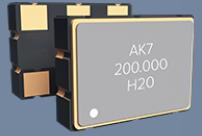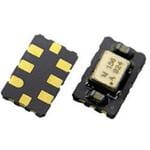In 5G network applications, the timing requirements for network nodes are very high. Network devices need stable clocks to shorten the locking time, reduce holdover drift, and improve synchronization. Therefore, high-performance crystal oscillators must be used to ensure stable system operation. This article will introduce characteristics of high-performance crystal oscillators and Abracon's compact, jitter-optimized crystal oscillator solutions.
The system imposes increasingly stringent requirements on clock jitter
With the development of technology, more and more applications impose increasingly stringent requirements on system clock jitter. Most require an upper limit of 200fs maximum RMS jitter over 12kHz to 20MHz bandwidth for a 156.25MHz carrier.
There are currently four fundamental ways to design a 156.25MHz clock oscillator:
- Quartz oscillator utilizing an inverted mesa quartz blank as the resonator element.
- Quartz oscillator utilizing a third overtone quartz blank as the resonator element.
- Oscillator loop based on a sub-50MHz third overtone/fundamental mode quartz blank or a sub-50MHz temperature-compensated crystal oscillator mated with an integer or fractional mode phase-locked-loop (PLL) IC.
- Sub-50MHz MEMS resonator-based oscillator loop mated with an integer or fractional mode phase-locked loop (PLL) IC.
Option A neither yields the best RMS jitter performance nor is the lowest cost solution. The MEMS resonator-approach [Option D] does not meet the primary performance criteria of 200fs maximum RMS jitter. Option B utilizes an optimally designed third overtone quartz blank with considerations given to the geometry of the electrodes and the optimization of the angle of cut, which provides the best convergence in cost, performance, and size.
Various crystal oscillator products meet different requirements
Abracon is a supplier of passive components, providing specialized timing/frequency control, magnetic/inductor, RF/antenna, and LAN connectivity solutions. Abracon saw the growing demand for ultra-low RMS jitter clock solutions, so it introduced a number of high-performance crystal oscillators to provide clocking solutions for 5G network nodes, including low phase noise crystal oscillators (XO) and high-precision temperature compensated crystal oscillators (TCXO).
Abracon introduced the ultra-low jitter third overtone ClearClock™ XO solutions (including the AK2, AX3, AK5, and AK7 series) to support customers who need a 100 to 200 MHz micro-sized clock solution. These requirements usually affect applications such as 5G communication, PCI Express (PCIe), optical transceivers, data storage, and network designs.
Additionally, Abracon launched its ASGTX5 series of temperature compensated crystal oscillators (TCXO) to address both over-temperature and long-term stability requirements of Stratum-IV architectures. The ASGTX5 series combines high-frequency clock output capabilities with a small footprint of 5.0 x 3.2 mm for high-stability applications in networking and communications that require compact component solutions.
ClearClock™ XO series offer superior RMS jitter performance
The ClearClockTM family of crystal oscillators is particularly suited for optical transceivers and data center architectures, which predominantly employ a 156.25MHz local oscillator with superior phase noise and RMS jitter performance as system clocks for 10G, 40G, 100G, and upcoming 400G systems.

AK7
Abracon's new AK2, AX3, AK5 & AK7 ClearClock™ crystal oscillator solutions are designed to meet the needs of compact applications such as optical modules, active cables, and small networking and storage gear, while supporting data rates in excess of 10Gbps and up to 100/400Gbps.
The AK2, AX3, AK5, and AK7 ClearClockTM XO series are designed with third overtone, high-Q quartz blanks using a specific angle of cut to satisfy the stringent frequency stability requirements over the extended operating temperature range of -40⁰C to +85⁰C. These solutions offer superior RMS jitter performance, significantly exceeding system-level requirements.
This next generation of ClearClock™ is ideal for applications requiring carrier frequencies in the 100MHz to 200MHz range. Most network processors and advanced CPUs require ultra-low jitter for connectivity greater than 10Gb per second and up to 100Gbps. Since the AK2, AX3, AK5, and AK7 devices utilize a quieter third overtone architecture that avoids phase locked loop (PLL) based multiplication, they provide the best combination of ultra-low jitter performance (less than 100fs) in a miniature footprint and reduce overall power consumption far below other high-performance XO alternatives. They typically consume 30mW of power at the lowest operating voltage of 1.8V.
ASGTX5 TCXO series is optimized for high stability and low noise
In addition to the standard frequency (non-factory-configurable) ClearClockTM solutions, Abracon has developed the ASGTX5 series to address the Stratum-IV clocking systems that have an all-inclusive total stability requirement of ±32ppm maximum. This requirement is inclusive of initial set-tolerance, shift through reflow, frequency pulling and pushing, frequency stability over -40⁰C to +85⁰C, and long-term aging (20 years).

ASGTX5DAF1-200.0000
The ASGTX5 temperature-compensated crystal oscillator (TCXO) solution meets this stringent requirement at any carrier frequency between 15.0MHz and 2.1GHz. However, to achieve that precision, this solution has slightly inferior RMS jitter compared to its third overtone ClearClockTM counterparts. For instance, the ASGTX5 exhibits < 350fs typical RMS jitter at 156.25MHz carrier.
These factory programmable devices are available in a 5.0 x 3.2 x 1.8 mm SMT package and have an all-inclusive frequency stability below the ±32 ppm required by Stratum-IV. Additionally, the ASGTX5 is available in all four standard differential output formats (LVDS, HCSL, LVPECL or CML) at any carrier frequency between 15MHz and 2.1GHz, including a high 700MHz output frequency in the HCSL format. This series is ideally suited for systems that either require stringent frequency accuracy, high carrier frequencies (such as 1.00GHz), or CML differential output.
Conclusion
As countries around the world are accelerating the pace of 5G construction, the market demand for high-performance crystal oscillators is also more intense. Abracon's ClearClock™ XO and ASGTX5 TCXO series can combine demanding clock stability and high frequency outputs in small package sizes to achieve higher performance levels and deliver superior benefits for communications infrastructure, making them ideal solutions for developing 5G-related applications.
In addition, Abracon has developed a family of oven-controlled crystal oscillators (OCXO) for 5G applications. The high-precision AOC1409 & AOC2012 series meet Stratum 3 and 3E requirements. Exhibiting ±10ppb precision stability over temperature combined with an ultra-low ±1ppb daily aging enables a ±15ppb, 24-hour holdover accuracy, depending on system conditions.
Ähnliches Produkt:
Ähnliches Produkt:



